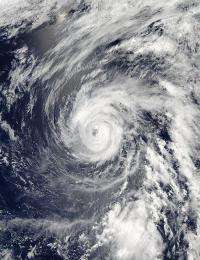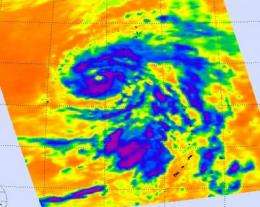Typhoon Sanvu affecting Iwo To, then expected to fade over weekend

Infrared and visible imagery from NASA's Aqua satellite taken on May 25, 2012, showed an impressive Typhoon Sanvu already affecting the islands of Iwo To and Chichi Jima, Japan. The typhoon is expected to run into cooler waters and become extra-tropical over the next several days.
Infrared imagery from May 25 at 0353 UTC (May 24, 1153 p.m. EDT) by NASA's Atmospheric Infrared Sounder (AIRS) instrument that flies onboard NASA's Aqua satellite showed a large area of high, cold cloud tops around Sanvu's eye. The strongest storms appear south of the eye, and in a band to the north of the eye. Those storms have cloud top temperatures colder than -63F (-52C), indicating they are high in the troposphere. Over the last 24 hours, those cloud tops have actually cooled, indicating they were getting higher, and the storms were intensifying. That's because the upper-level atmosphere was cooling.
On May 25, 2012 at 1500 UTC (11 a.m. EDT/U.S.), Typhoon Sanvu had maximum sustained winds near 60 knots (69 mph/111 kph), slightly weaker than it was on May 24. Typhoon-force winds cover a compact area, extending 25 miles (40 km) from the center, while tropical storm-force winds extend as far as 150 miles (241.4 km) from the center, making the storm over 300 miles (~483 km) in diameter.

Sanvu's center was located near 23.9 North and 140.3 East, only 100 nautical miles (115 miles/185 km) southwest of Iwo To, Japan and moving to the north-northeast at 7 knots (8 mph/13 kph). Sanvu continues to churn up rough seas, and the Joint Typhoon Warning Center reported that wave heights in the region are as high as 31 feet (9.4 meters).
Another instrument on NASA's Aqua satellite captured a stunning view of Typhoon Sanvu that clearly showed an eye. The image was taken on May 25 at 0355 UTC from the Moderate Resolution Imaging Spectroradiometer (MODIS) instrument onboard Aqua.
Iwo To and Chichi Jima will continue to experience rough surf, showers, thunderstorms and gusty winds today, as well as on Saturday, May 26. On May 25 at 11 a.m. U.S. Eastern Time, Iwo To was experiencing thunderstorms and winds from the east between 40 to 55 mph (64 to 88.5 kph). Winds are expected to shift to the north as Sanvu continues moving by. Rainfall of up to 2 inches (50 mm) is expected on the island with more on May 26.
Forecasters at the Joint Typhoon Warning Center noted that Sanvu has likely reached its maximum intensity and will hold there before starting to weaken early on May 26 (U.S. Eastern Time). Once Sanvu gets up to 25 degrees North latitude, the ocean surface temperatures are much cooler, and will weaken the storm. A tropical cyclone needs a sea surface temperature of 80F/26.6C to maintain intensity. On May 25, Sanvu is located in an area where sea surface temperatures are around 27 Celsius (80.6F), and temperatures where it is headed are as cold as 23 Celsius (73.4F).
In addition to the cooler ocean temperatures, wind shear is expected to kick up over the next couple of days and will help weaken the storm. By the end of the weekend, Sanvu is expected to transition to an extra-tropical low pressure area in the Northern Pacific Ocean.
Provided by NASA's Goddard Space Flight Center





















